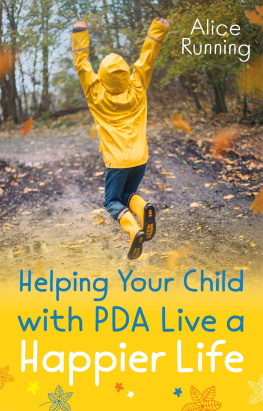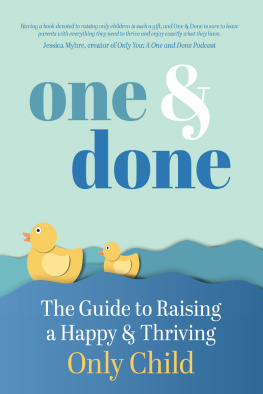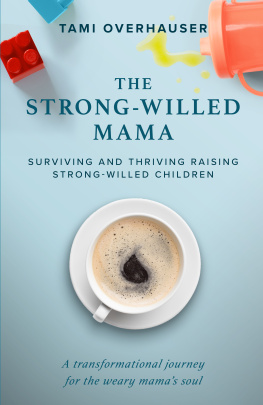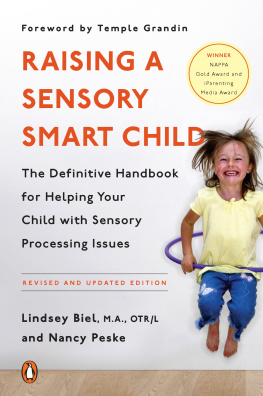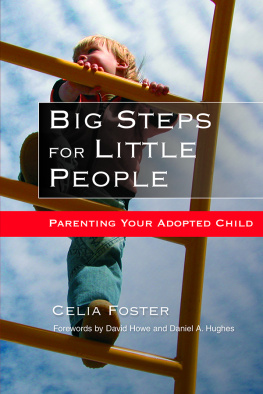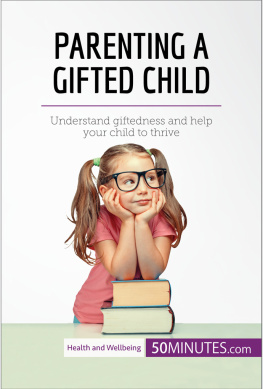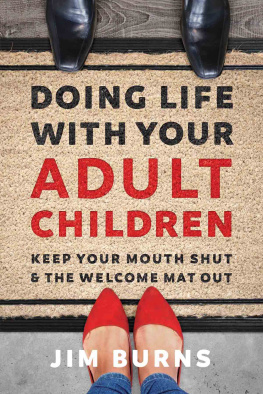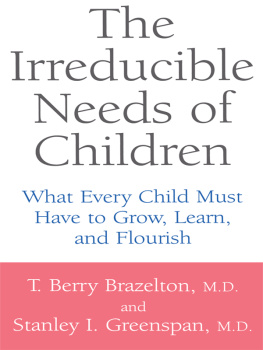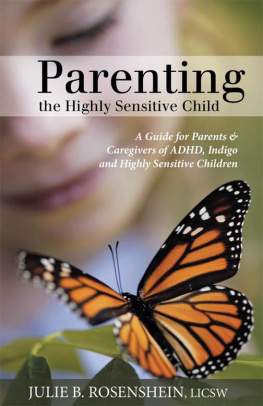Contents
Page list

of related interest
Pathological Demand Avoidance Syndrome My Daughter is Not Naughty
Jane Alison Sherwin
ISBN 978 1 84905 614 4
eISBN 978 1 78450 085 6
Being Julia - A Personal Account of Living with Pathological Demand Avoidance
Ruth Fidler and Julia Daunt
Foreword by Dr Judy Eaton
ISBN 978 1 84905 681 6
eISBN 978 1 78450 188 4
The PDA Paradox
The Highs and Lows of My Life on a Little-Known Part of the Autism Spectrum
Harry Thompson
Foreword by Felicity Evans
ISBN 978 1 78592 675 4
eISBN 978 1 78592 677 8
Me and My PDA
A Guide to Pathological Demand Avoidance for Young People
Glria Dur-Vil and Tamar Levi
ISBN 978 1 78592 465 1
eISBN 978 1 78450 849 4
Helping Your Child with
PDA Live a Happier Life
Alice Running

First published in Great Britain in 2022 by Jessica Kingsley Publishers
An Hachette Company
Copyright Alice Running 2021
Front cover image source: Shutterstock. The cover image is for illustrative purposes only, and any person featuring is a model.
All rights reserved. No part of this publication may be reproduced, stored in a retrieval system, or transmitted, in any form or by any means without the prior written permission of the publisher, nor be otherwise circulated in any form of binding or cover other than that in which it is published and without a similar condition being imposed on the subsequent purchaser.
A CIP catalogue record for this title is available from the British Library and the Library of Congress
ISBN 978 1 78775 485 0
eISBN 978 1 78775 486 7
Jessica Kingsley Publishers policy is to use papers that are natural, renewable and recyclable products and made from wood grown in sustainable forests. The logging and manufacturing processes are expected to conform to the environmental regulations of the country of origin.
Jessica Kingsley Publishers
Carmelite House
50 Victoria Embankment
London EC4Y 0DZ
www.jkp.com
Dedicated to my two wonderful sons, who are
both perfect and whom I love so very much.
And to Charlie, the best dog.
Acknowledgements
I would like to thank my family for their unwavering support. They have provided strength and solidarity during all the many difficult meetings I have had while trying to advocate for my children. I would like to thank my mother, who has provided endless (free) caring support to my children when local services have not.
I would also like to thank Helen, and all the other support groups who offer genuine understanding, good advice and expertise if only those in power would listen to the autism community more.
Contents
Introduction
Setting Pathological Demand
Avoidance in Context
Pathological demand avoidance (PDA) is increasingly becoming recognized as a distinct, neurological difference that is part of the autism spectrum pathological demand avoidance is an autism spectrum condition. However, PDA is not yet identified via current diagnostic criteria for autism and so many people receive a diagnosis of autism with demand avoidance, instead of a diagnosis of pathological demand avoidance in its own right.
Many children receive a diagnosis of autism but then go on to find that this diagnosis does not necessarily address all challenges experienced during daily life. Pathological demand avoidance can be explained as a permanent struggle with ones internal self, leading to automatic resistance to demands made of us. Demands can be as seemingly trivial as using the toilet or speaking. Resistance to demands is not a choice and is related to how a neurodiverse mind is expected to cope within an intolerable, neurotypical world.
A PDA mind is an autistic mind and will share similar experiences in relation to interacting with non-autistic people and environments intolerable sensory experiences, communication differences, detailed focus and alternative social imagination. But a PDA mind may find typical autism-friendly approaches and strategies painful to experience, resulting in an increased distress response. In my opinion, this is why it is so important to distinctly categorize PDA as a presentation. Using traditional autism interventions and strategies may be as harmful to a PDA child as using traditional neurotypical parenting approaches. For a PDA child, life is experienced in permanent anxiety and this fear is exacerbated through having things done to them, rather than with them. Collaboration is key to engagement and to collaborate successfully with a PDA child, we must first understand the world from their point of view.
Pathological demand avoidance is a neurological difference and children who are diagnosed with PDA are born this way. There is significant debate within the autism community with regards to pathological demand avoidance as a separate, diagnostic identity. Some autistic people feel that demand avoidance is a rational response, rooted in anxiety at having to operate within a non-autism-friendly world or environment. There are many autistic people who consider demand avoidance to be a trauma response to misguided autism interventions. This book does not focus on these debates but aims to offer practical advice, based on real-life experience, with the aim of making life happier for autistic children with demand avoidance as part of their interaction with the world.
I am autistic. I have two autistic children who experience levels of anxiety to such a degree that life can become intolerable for them. They have both been professionally assessed as fitting the criteria for pathological demand avoidance. Unfortunately, in the area in which we live, our local authority does not recognize PDA as a distinct part of the autism spectrum and tends to explain complexities as behavioural or exacerbated by poor parenting. It is a difficult position to be in, as advocating in your childs best interests can place you in direct opposition with those who have a duty of care for your child (health, education, social care). I have experienced first-hand how the wrong type of environment or wrong teaching approach can disable my children in a way that their autistic minds will never do. An autistic or PDA mind is not an innate disabler, but how outside, societal interventions treat an autistic person can be extremely disabling.
Behavioural or corrective interventions can be extremely damaging to an autistic mind, as perceived behaviour is essentially a communication of distress that something is intolerable to our neurodiversity. Cognitive behavioural therapies and applied behavioural analysis aim to retrain thought processes, and subsequent behavioural responses. But if the cause of the behaviour that needs addressing is essentially how an autistic mind experiences an environment that is not inclusive, then no behavioural change will ever occur without the disabling environment adapting to the needs of an autistic mind.
In mainstream school my children simply could not cope. The noise, the constant anxiety at not being able to effectively connect with the people around them and the permanent demands to do so left them distraught and traumatized at a very young age. The only way forward for our family at this juncture was to remove them from the school environment and allow this heightened distress to naturally dissipate. Their mental health took priority over their academic journey for several years, and without this intervention it is likely that they both would have become extremely ill indeed. When distress gets too high, it can become impossible to manage, and until anxiety has reduced holistically, no approach will be helpful.

